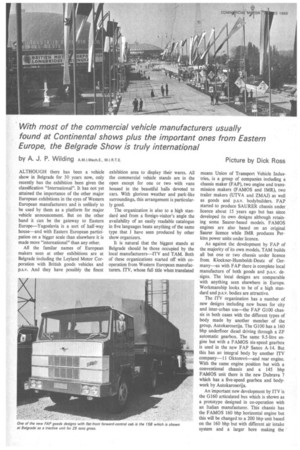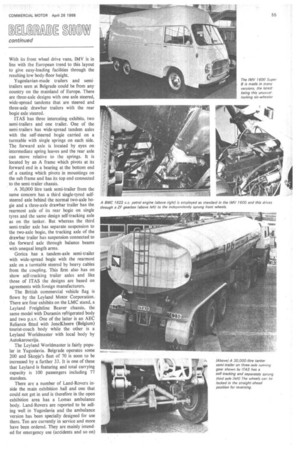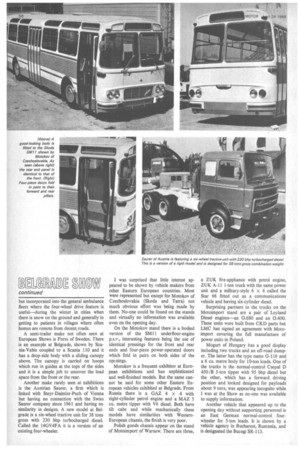With most of the commercial vehicle manufacturers usually found at
Page 52

Page 54

Page 57

Page 58

If you've noticed an error in this article please click here to report it so we can fix it.
Continental shows plus the important ones from Eastern Europe, the Belgrade Show is truly international
by A. J. P. Wilding A.M.I.Mech.E., M.I.R.T.E. Picture by Dick Ross
ALTHOUGH there has been a vehicle show in Belgrade for 30 years now, only recently has the exhibition been given the classification "International". It has not yet attained the importance of the other major European exhibitions in the eyes of Western European manufacturers and is unlikely to be used by them as a platform for major vehicle announcement. But on the other hand it can be the gateway to Eastern Europe—Yugoslavia is a sort of half-way house—and with Eastern European participation on a bigger scale than elsewhere it is made more "international" than any other.
All the familar names of European makers seen at other exhibitions are at Belgrade including the Leyland Motor Corporation with British goods vehicles and p.s.v. And they have possibly the finest exhibition area to display their wares. All the commercial vehicle stands are in the open except for one or two with vans housed in the beautiful halls devoted to cars. With glorious weather and park-like surroundings, this arrangement is particularly good.
The organization is also to a high standard and from a foreign-visitor's angle the availability of an easily readable catalogue in five languages beats anything of the same type that 1 have seen produced by other show organizers.
It is natural that the biggest stands at Belgrade should be those occupied by the local manufacturers—ITV and TAM. Both of these organizations started off with cooperation from Western European manufacturers. ITV, whose full title when translated means Union of Transport Vehicle Industries, is a group of companies including a chassis maker (FAP), two engine and trans mission makers (FAMOS and IMR), two trailer makers (UTVA and ZMAJ) as well as goods and p.s.v. bodybuilders. FAP started to produce SAURER chassis under licence about 15 years ago but has since developed its own designs although retaining some Saurer-based models. FAMOS engines are also based on an original Saurer licence while IMR produces Perkins power units under licence.
As against the development by FAP of the majority of its own models, TAM builds all but one or two chassis under licence from. Klockner-Humboldt-Deutz of Germany—as with FAP there is complete local manufacture of both goods and p.s.v. designs. The local designs are comparable with anything seen elsewhere in Europe. Workmanship looks to be of a high standard and p.s.v. bodies are attractive.
The ITV organization has a number of new designs including new buses for city and inter-urban use—the FAP G100 chas sis in both cases with the different types of body made by another member of the group, Autokaroserija. The G100 has a 160 bhp underfloor diesel driving through a ZF automatic gearbox. The same 9.5-litre en gine but with a FAMOS six-speed gearbox is used in the new FAP Sanos A-14. But this has an integral body by another ITV company-11 Oktomvri—and rear engine.
With the same engine position but with a conventional chassis and a 145 bhp FAMOS unit there is the new Dubrava 7 which has a five-speed gearbox and bodywork by Autokaroserija.
An important new development by ITV is the G160 articulated bus which is shown as a prototype designed in co-operation with an Italian manufacturer. This chassis has the FAMOS 160 bhp horizontal engine but this will be changed to a 200 bhp unit based on the 160 bhp but with different air intake system and a larger bore making the ' capacity 10 litres.
In the goods field there are FAP designs with flat-front and curved forward-control cabs of good standard, and maximum gross-design weights up to 38 tons when used with a drawbar or semi-trailer are made. In the biggest, an engine with an output of 200 bhp at 2,300 rpm is used in conjunction with a ZF 12-speed overdrive transmission. The FAP 18B comes into this category and a new version is the 18BK which is a tipper with the curved forwardcontrol cab.
New models with the flat-front cab include the 10B 6.5 toriner with 118 bhp engine and the 15B for 15.6 tons solo and 29 tons with trailer or semi-trailer in which case the engine is the 160 bhp and the gearbox a six-speed; as with all the other heavy FAP models the steering is power assisted.
There are no really new models by TAM which shows new bodies on existing p.s.v. chassis and among the trucks a light design with road-gritting body. The latter is interesting as the design allows the body and equipment to be removed easily and changed for a tipping body. As well as the heavy goods models based on Magirus Deutz, TAM produces its own designs with forward-control cabs and also small trucks which use Perkins engines made by IMR. It also makes its own designs of specialpurpose vehicles.
Commercial vehicle manufacture in Yugoslavia is not limited to medium and heavy models. An important company is Industrija Motornih Vozil (Imv) which produces vans and caravans. It also handles sales of BMC cars in Yugoslavia and occupies a complete hall at the exhibition.
IMV first went into production with its own van design in 1960 and the current 1600 Super B Series was introduced in 1967. Originally the 1600 had an Auto Union engine but about a year ago a BMC 1,622 c.c. petrol engine was applied to the model and this is now used exclusively. The engine drives through a ZF gearbox to the front wheels of the van which has a capacity of 1 ton and there is independent suspension all round with trailing links and transverse torsion bars at the rear. With sales around 2,500 a year this is good engine business for BMC to add to the car sales which were said to be running currently at 1,000 a year. and BMC has greater hopes and expectations, for on the opening day of the Show IMV signed an agreement to assemble a car model—IM V has capacity to produce 5,000 a year.
An interesting new version of the IMV 1600 is a six-wheeler. This unusual-looking van has a raised roof also and the interior capacity is increased to 265 cu.ft. from the normal 194 cu.ft. while payload rating goes up from 1 to 1.5 tons. Apart from the body the only change is the addition of a duplicated set of rear suspension components, etc., and 6.00-16 wheels and tyres are retained. With its front wheel drive vans, IMV is in line with the European trend to this layout to give easy-loading facilities through the resulting low body-floor height.
Yugoslavian-made trailers and semitrailers seen at Belgrade could be from any country on the mainland of Europe. There are three-axle designs with one axle steered, wide-spread tandems that are steered and three-axle drawbar trailers with the rear bogie axle steered.
ITAS has three interesting exhibits, two semi-trailers and one trailer. One of the semi-trailers has wide-spread tandem axles with the self-steered bogie carried on a turntable with single springs on each side. The forward axle is located by eyes on intermediate spring leaves and the rear axle can move relative to the springs. It is located by an A frame which pivots at its forward end in a bearing at the bottom end of a casting which pivots in mountings on the sub frame and has its top end connected to the semi-trailer chassis.
A 30,000 litre tank semi-trailer from the same concern has a third single-tyred selfsteered axle behind the normal two-axle bogie and a three-axle drawbar trailer has the rearmost axle of its rear bogie on single tyres and the same design self-tracking axle as on the tanker. But whereas the third semi-trailer axle has separate suspension to the two-axle bogie, the tracking axle of the drawbar trailer has suspension connected to the forward axle through balance beams with unequal length arms.
Gorica has a tandem-axle semi-trailer with wide-spread bogie with the rearmost axle on a turntable steered by heavy cables from the coupling. This firm also has on show self-tracking trailer axles and like those of ITAS the designs are based on agreements with foreign manufacturers.
The British commercial vehicle flag is flown by the Leyland Motor Corporation. There are four exhibits on the LMC stand, a Leyland Freightline Beaver chassis, the same model with Duramin refrigerated body and two p.s.v. One of the latter is an AEC Reliance fitted with JoncKheere (Belgium) tourist-coach body while the other is a Leyland Worldmaster with local body by Autokaroserija.
The Leyland Worldmaster is fairly popular in Yugoslavia. Belgrade operates some 200 and Skopje's fleet of 70 is soon to be increased by a further 33. It is one of these that Leyland is featuring and total carrying capacity is 100 passengers including 77 standees.
There are a number of Land-Rovers inside the main exhibition hall and one that could not get in and is therefore in the open exhibition area has a Lomas ambulance body. Land-Rovers are reported to be selling well in Yugoslavia and the ambulance version has been specially designed for use there. Ten are currently in service and more have been ordered. They are mainly intended for emergency use (accidents and so on) but incorporated into the general ambulance fleets where the four-wheel drive feature is useful—during the winter in cities when there is snow on the ground and generally in getting to patients in villages where often homes are remote from decent, roads.
A semi-trailer make not often seen at European Shows is Forss of Sweden. There is an example at Belgrade, shown by Scania-Vabis coupled to a Scania 110 and it has a drop-side body with a sliding canopy above. The canopy is carried on hoops which run in guides at the tops of the sides and it is a simple job to uncover the load space from the front or the rear.
Another make rarely seen at exhibitions is the Austrian Saurer, a firm which is linked with Steyr-Dairnler-Puch of Vienna but having no connection with the Swiss Saurer company since 1961 and having no similarity in designs. A new model at Belgrade is a six-wheel tractive unit for 38 tons gross with 230 bhp turbocharged diesel. Called the 14GV4FA it is a version of an existing four-wheeler. I was surprised that little interest appeared to be shown by vehicle makers from other Eastern European countries. Most were represented but except for Motokov of Czechoslovakia (Skoda and Tatra) not much obvious effort was being made by them. No-one could be found on the stands and virtually no information was available even on the opening day.
On the Motokov stand there is a bodied version of the SM11 underfloor-engine p.s.v., interesting features being the use of identical pressings for the front and rear ends and four-piece power-operated doors which fold in pairs on both sides of the opt flings.
Motokov is a frequent exhibitor at European exhibitions and has sophisticated and well-finished models. But the same cannot be said for some other Eastern European vehicles exhibited at Belgrade. From Russia there is a GAZ 4 X 4 with eight-cylinder petrol engine and a MAZ 5 Cu. metre tipper with V6 diesel. Both have tilt cabs and while mechanically these models have similarities with WesternEuropean chassis, the finish is very poor.
Polish goods chassis appear on the stand of Motoimport of Warsaw. There are three, a ZUK fire-appliance with petrol engine, ZUK A-11 1-ton truck with the same power unit and a military-style 6 X 6 called the Star 66 fitted out as a communications vehicle and having six-cylinder diesel.
Surprising partners to the trucks on the Motoimport stand are a pair of Leyland Diesel engines—an 0.680 and an 0.400. These units were built from CKD parts but LMC has signed an agreement with Motoimport covering the full manufacture of power units in Poland.
Mogurt of Hungary has a good display including two trucks and an off-road dumper. The latter has the type name G-116 and a 6 cu. metre body for 10-ton loads. One of the trucks is the normal-control Csepal D 450/B 5-ton tipper with 95 bhp diesel but the other, which has a forward driving position and looked designed for payloads about 9 tons, was appearing incognito while I was at the Show as no-one was available to supply information.
Another vehicle that appeared up to the opening day without supporting personnel is an East German normal-control fourwheeler for 5-ton loads. It is shown by a vehicle agency in Bucharest, Rumania, and is designated the Bucegi SR-113.




















































































































